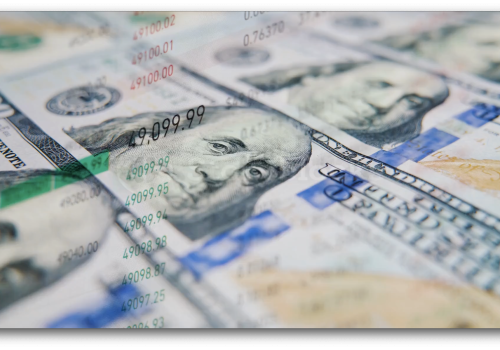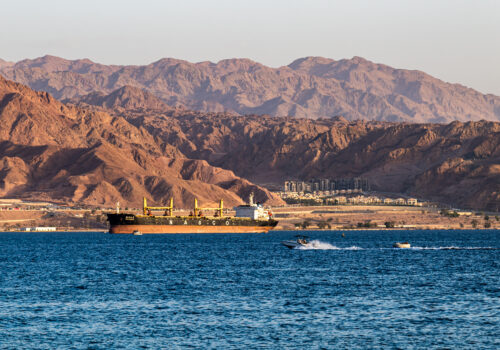
June 20, 2024
Is the end of the petrodollar near?
Editors’ note: This article has been revised to reflect the fact that Saudi Arabia made no announcement on June 13 related to oil traded in US dollars. There is no official agreement between the United States and Saudi Arabia to sell oil in US dollars.
As countries from the BRICS group and regions including the Middle East and Asia increase the use of local currencies for cross-border payments, there is a growing perception that the dollar’s importance in international finance is ebbing, particularly in global oil markets and the use of the petrodollar.
What exactly is the petrodollar? In short, it’s a commitment by Saudi Arabia to use dollar revenues from oil sales to the United States to buy US Treasuries. But the history is more complicated.
America and Saudi Arabia in 1974
Let’s take a look back to the Nixon administration. The United States was beset by high inflation and large current-account deficits amid an ongoing war in Vietnam, putting downward pressure on the dollar and threatening a run on US gold reserves. In 1971, the United States ended the dollar’s convertibility to gold which had been the lynchpin of the Bretton Woods international monetary system of fixed exchange rates. Major currencies began to float against each other in 1973. Then came the oil shock that fall, when the Organization of Petroleum Exporting Countries (OPEC) cut oil production and embargoed shipments to the United States during the Yom Kippur war.
Against a backdrop of great economic and political uncertainty, as the Watergate hearings pushed toward their close, the Nixon administration embarked on a diplomatic mission that would cement an economic partnership with Saudi Arabia that has been central to the global energy trade. To encourage Riyadh’s use of the dollar as the medium of exchange for its oil sales,(and thereby funnel those dollars back into Treasury bond markets to help finance US fiscal deficits), Washington promised to supply military equipment to Saudi Arabia and protect its national security. Despite the tumult and instability in the United States at that time, the deal showed that it retained the power to set the international agenda. In addition to keeping demand for the dollar stable, the agreement promoted its use in oil and commodities trading, while creating a steady source of demand for US Treasuries. This helped to strengthen the dollar’s position as the world’s key reserve, financing and transactional currency.
A brave new world
Fast-forward fifty years, and the dominant global position once enjoyed by the United States has comparatively weakened. Its share of world gross domestic product has declined from 40 percent in 1960 to 25 percent. China’s economy has surpassed the United States in purchasing power parity terms. It now has to vie for influence with an increasingly assertive Beijing, while facing pushes even by allies such as Europe and elsewhere that want to become more autonomous from Washington in financial and foreign policy matters. Specifically, many countries have tried to develop alternative cross-border payment arrangements to the dollar to reduce their vulnerability to Washington’s increasing use of economic and financial sanctions.
At the same time, the United States has become far less dependent on Saudi oil. Thanks to the shale revolution, in fact, the United States is now the largest oil producer in the world and a net exporter. It still imports oil from Saudi Arabia but at a significantly lower volume. By contrast, China has become Saudi Arabia’s largest oil customer, accounting for more than 20 percent of the kingdom’s oil exports. Beijing has established close, trade-driven relationships throughout the Middle East, where US influence has waned.
Saudi Arabia’s willingness to diversify the currencies used in selling its oil aligns with a larger strategy that requires the county to increase its international relations beyond the United States and Europe. The Kingdom’s willingness to join the BRICS club of emerging nations and partner with China and other countries in the mBridge project to explore the use of their respective central bank digital currencies (CBDCs) for cross-border payments should not be surprising.
The dollar’s global dilemma
Saudi Arabia’s interest in currency diversification marks a small but symbolic step down the road toward de-dollarization. Increasingly, countries are using their own currencies in cross-border trade and investment transactions. The arrangements necessary to do so exist entirely outside the influence of any major power. These include currency-swap lines agreed between participating central banks and the linking of national payment and settlement systems. Using local/national currencies for cross-border payments currently entails an efficiency cost, as it relies on less liquid local foreign exchange, money, and hedging markets to directly exchange pairs of local currencies without the dollar as a vehicle. Many countries mentioned above appear to have accepted this cost as necessary to reduce their reliance on the dollar. Advances in digital payment technology, such as tokenization, would greatly reduce such costs.
Over the past few years, the digital payment ecosystem has progressed significantly toward what is known as “tokenization” units of exchange such as CBDCs or stablecoins pegged to the dollar or any major currencies, a cryptocurrency designed to be fixed to a reference asset, etc. These tokenized units can be exchanged instantaneously and directly without having to be processed through the accounts of intermediaries such as commercial banks. Tokenized currencies are still a long way off from widespread adoption, but such an ecosystem would significantly reduce the need for participants to hold reserves to ensure adequate liquidity, weakening the role of the deep and liquid US Treasury securities market as a key pillar of support for the dollar’s dominant position in international finance. In fact, the share of the dollar in global reserves has already fallen from 71 percent in 1999 to 58.4 percent at present—in favor of several secondary currencies.
In the foreseeable future, the dollar’s dominance will remain. But a gradual democratization of the global financial landscape may be underway, giving way to a world in which more local currencies can be used for international transactions. In such a world, the dollar would remain prominent but without its outsized clout, complemented by currencies such as the Chinese renminbi, the euro, and the Japanese yen in a way that’s commensurate with the international footprint of their economies. In this context, how Saudi Arabia approaches the petrodollar remains an important harbinger of the financial future to come as its creation was fifty years prior.
Hung Tran is a nonresident senior fellow at the Atlantic Council’s Geoeconomics Center, a former executive managing director at the Institute of International Finance, and a former deputy director at the International Monetary Fund.

At the intersection of economics, finance, and foreign policy, the GeoEconomics Center is a translation hub with the goal of helping shape a better global economic future.
Further reading
Mon, Jan 8, 2024
The long shadow of the Red Sea shipping disruption
Econographics
By
Recent attacks on shipping moving through the red sea have exposed broader risks around international maritime commerce. Policy makers must use this wake-up call to build a more resilient international shipping ecosystem.
Image: Offshore Supply Ship and crude oil platform are moored near the coast of Red Sea in Saudi Arabia port


